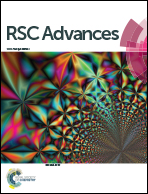Large-scale fabrication of porous bulk silver thin sheets with tunable porosity for high-performance binder-free supercapacitor electrodes†
Abstract
We report a novel method for the large-scale fabrication of porous bulk silver thin sheets (PSTS) built from three-dimensionally interconnected nanoparticles (NPs). The synthesis starts with synthesizing silver sponges via an in situ growth of NPs which assemble into networks. The sponges are pressed into thin sheets before etching in acid. The resulting porosity is nearly homogeneous throughout the whole volume. The dependence on acid concentration was investigated and the average pore diameter can be controlled in a range of 83–145 nm by etching time. Growing metal oxides results in PSTS/Co3O4 composites which can be used directly as binder-free supercapacitor electrodes. The Co3O4 growth is optimized and the optimized composite electrode provides a much higher specific capacitance (1276 F g−1 at 1 A g−1) than previously reported for pure Co3O4 nanostructures with different shapes or those for Ag–Co3O4 composite nanowire array electrodes. The optimal electrode has a superior rate capability (still 986 F g−1 at 10 A g−1). The improvements are attributed to the continuous open porosity of PSTS and a direct contact between Co3O4 and Ag ligaments. The method can be extended to many other metals or alloys, promising wide application.


 Please wait while we load your content...
Please wait while we load your content...